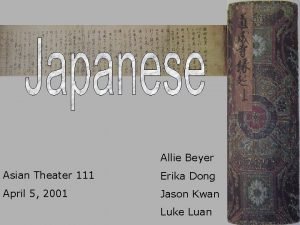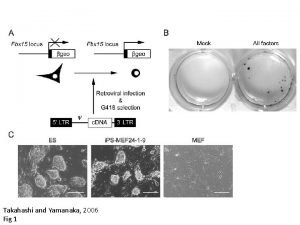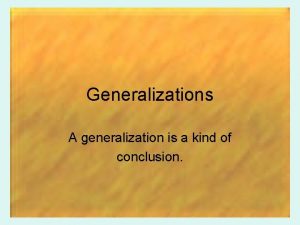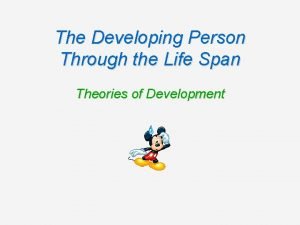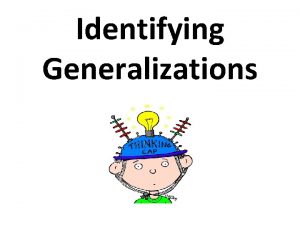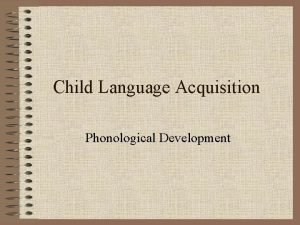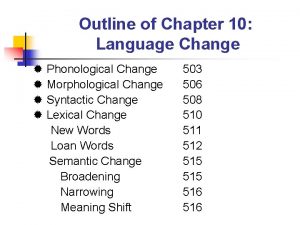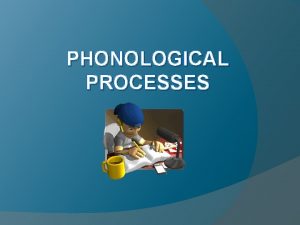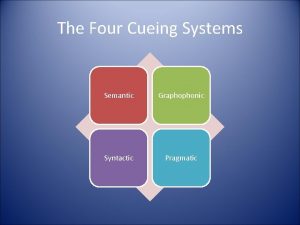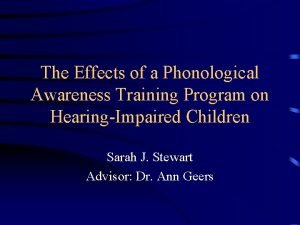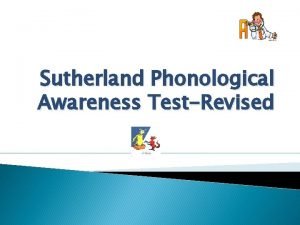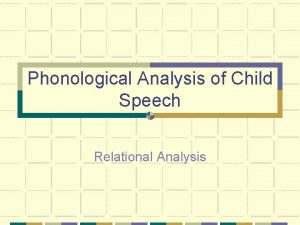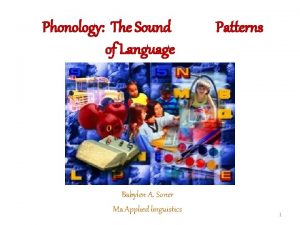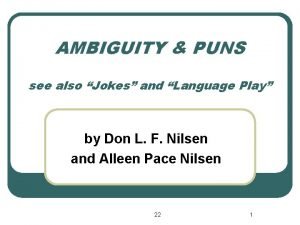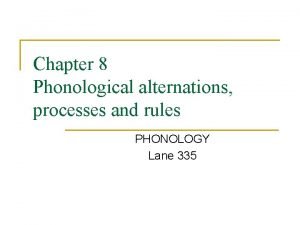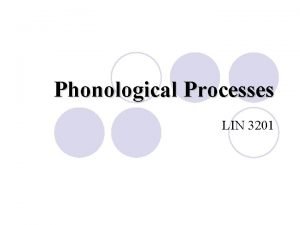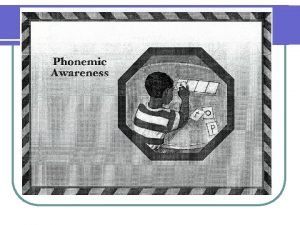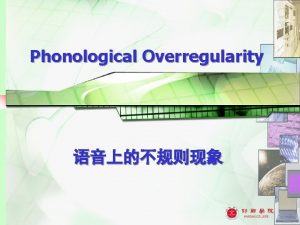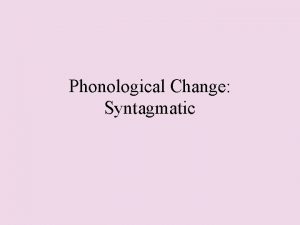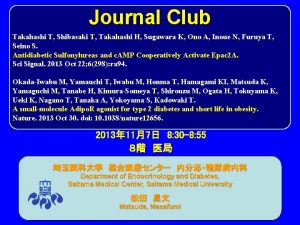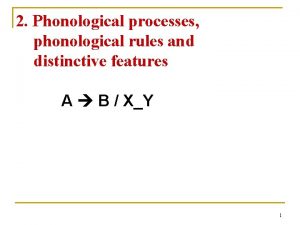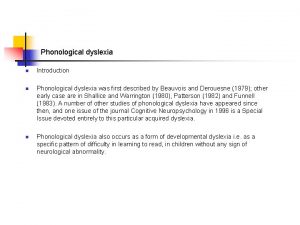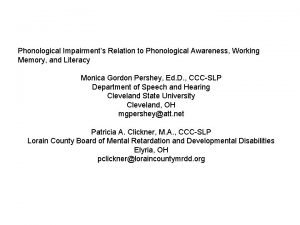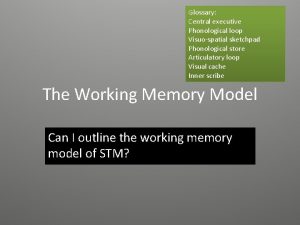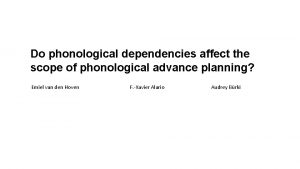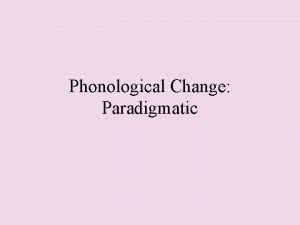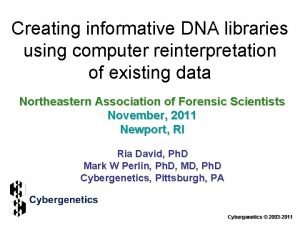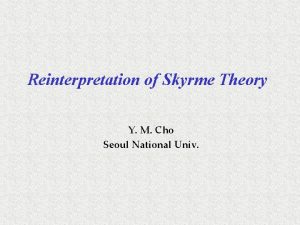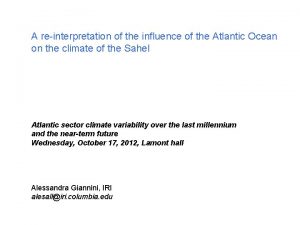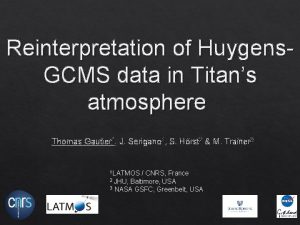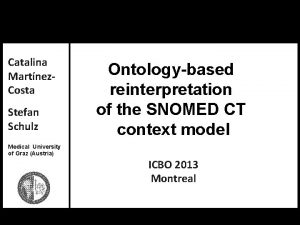A GameTheoretic ReInterpretation of Phonological Generalizations Yukio Takahashi




![Relevant Data • key [ ] an advanced variety of /k/ • caw [ Relevant Data • key [ ] an advanced variety of /k/ • caw [](https://slidetodoc.com/presentation_image/10da25342b85c707e7e26338778a8914/image-5.jpg)





![PPGs in [ ] and [ ] • PPG 1 for velic closure • PPGs in [ ] and [ ] • PPG 1 for velic closure •](https://slidetodoc.com/presentation_image/10da25342b85c707e7e26338778a8914/image-11.jpg)
![Hierarchy of the PPGs • [velic closure] Feature Spreading [lip rounding] [tongue root retraction] Hierarchy of the PPGs • [velic closure] Feature Spreading [lip rounding] [tongue root retraction]](https://slidetodoc.com/presentation_image/10da25342b85c707e7e26338778a8914/image-12.jpg)





![Pay-Off Matrix for [ ] lr: lip rounding PPG (Nucleus, 3 rd dim: spreading Pay-Off Matrix for [ ] lr: lip rounding PPG (Nucleus, 3 rd dim: spreading](https://slidetodoc.com/presentation_image/10da25342b85c707e7e26338778a8914/image-18.jpg)
![Pay-Off Matrix for *[ ] adv: advanced 3 rd dim: spreading PPG (nucleus, adv) Pay-Off Matrix for *[ ] adv: advanced 3 rd dim: spreading PPG (nucleus, adv)](https://slidetodoc.com/presentation_image/10da25342b85c707e7e26338778a8914/image-19.jpg)

![High Vowel Devoicing in Japanese • Standard Japanese [ ] “low” [ ] (*[ High Vowel Devoicing in Japanese • Standard Japanese [ ] “low” [ ] (*[](https://slidetodoc.com/presentation_image/10da25342b85c707e7e26338778a8914/image-21.jpg)
![Payoff Matrix for *[ ] in Standard Japanese PPG for Intercons onantal Devoicin g Payoff Matrix for *[ ] in Standard Japanese PPG for Intercons onantal Devoicin g](https://slidetodoc.com/presentation_image/10da25342b85c707e7e26338778a8914/image-22.jpg)
![Payoff Matrix for [ ] in Tohoku Dialect PPG for (+1, Spreadin +2) g Payoff Matrix for [ ] in Tohoku Dialect PPG for (+1, Spreadin +2) g](https://slidetodoc.com/presentation_image/10da25342b85c707e7e26338778a8914/image-23.jpg)



- Slides: 26

A Game-Theoretic Re-Interpretation of Phonological Generalizations Yukio Takahashi 高橋幸雄 Morioka College 盛岡大学 The research has been supported in part by the Grant-in-Aid for Scientific Research for the years 2006 -2007 (No: 18520389) by The Japan Society for the Promotion of Science and by Morioka College Academic Grant for the year 2005 1

Purposes • Description of Game-Theoretic Approach to the Theory of Phonology • Game-Theoretic Re-interpretation (Reanalysis) of Phonological Generalizations • Computationally Implementable Framework of Phonology 2

Assumptions • The theoretical model of phonology internalizes hierarchically organized phonological computational gadgets that give more than one articulatory strategy • The outputs of the system are states of equilibria among the articulatory strategies • The activity of articulating a linguistic sound is a “game” among these gadgets 3

Structure of the Presentation • Definition of the Game-Theoretic Approach to Phonology: Strategies, Society of Phonological Mind, Pay-Off Matrices… Autosegmental Spreading of Features, Underspecification • Game-Theoretic Reinterpretation of Coarticulation 4
![Relevant Data key an advanced variety of k caw Relevant Data • key [ ] an advanced variety of /k/ • caw [](https://slidetodoc.com/presentation_image/10da25342b85c707e7e26338778a8914/image-5.jpg)
Relevant Data • key [ ] an advanced variety of /k/ • caw [ ] a rounded and retracted variety of /k/ (Kühnert and Nolan (1999: 7) • devoicing of /l/ in [ ] Jones (19609: 220) 5

Non-Cooperative Strategies in Coarticulation • Strategic interplay of the phonological processing gadgets A better understanding of coarticulation has come from investigations … on the effects of articulatory constraints on the coarticulatory movements, i. e. on the complex interplay between influencing and influenced sounds, and on the relationship between coarticulation and articulatory antagonism [Farnetani (1990: 96)] 6

Research Scheme • Society of Phonological Mind (Cf. Takahashi 2006, to appear) The theoretical model of phonology internalizes hierarchically organized phonological computational gadgets that give more than one articulatory strategy. The outputs of the phonology are states of equilibria among the articulatory strategies. 7

Assumptions on Phonological Processing Gadgets • Linguistic articulations of sounds emerge out of the interactions of articulatory strategies of PPGs. • PPGs are composed of smaller agents (PPGs) that cannot plan articulatory strategies. • Articulatory strategies of a PPG are selected and applied so as to reach equilibria with those of other PPGs. 8

Major Elements of the Phonological Mind • Autosegmental Spreading of Features: Spreading of terminal features in featuregeometric representations (Cf. Sagey (1986)) • Structure Preservation In the lexicon, restrictions on underlying representations are applied to derived representations (Cf. Kiparsky (1982, 1985)) 9

S- and K-Societies of Phonological Mind • Overall Architecture of the Society of Phonological Mind Cognitive Effect S-Society (Spreading of Features) K-Society (Structure Preservation) 10
![PPGs in and PPG 1 for velic closure PPGs in [ ] and [ ] • PPG 1 for velic closure •](https://slidetodoc.com/presentation_image/10da25342b85c707e7e26338778a8914/image-11.jpg)
PPGs in [ ] and [ ] • PPG 1 for velic closure • PPG 2 for lip rounding • PPG 3 for retracting the tongue root • PPG 4 for advancing the body of the tongue • PPG 5 for feature spreading 11
![Hierarchy of the PPGs velic closure Feature Spreading lip rounding tongue root retraction Hierarchy of the PPGs • [velic closure] Feature Spreading [lip rounding] [tongue root retraction]](https://slidetodoc.com/presentation_image/10da25342b85c707e7e26338778a8914/image-12.jpg)
Hierarchy of the PPGs • [velic closure] Feature Spreading [lip rounding] [tongue root retraction] [advanced tongue root] The higher the PPG, the larger the value of (non-) achievements. 12

Principles of Pay-Off Calculation • Pay-Off for PPGs • Anchoring on the temporal elements in featuregeometric representations in the sense of Sagey (1986) • Application of Unmarked Strategies: [1] • Non-Application of (Un-)marked Strategies: [Ø] • Application of Marked Strategies: [– 1] 13

Notation • ON and OFFS of PPGs • PPG (F) is a functional notation for the PPG that executes the articulatory process F. • PPG (a, b) stands for the linkage of PPG (a) with PPG (b) 14

Assumptions on Markedness • By default, /k/ is OFF wrt roundedness • By default, /k/ is OFF wrt retractedness • By default, /k/ is OFF wrt advancedness • Spreading of features values is an instance of the application of unmarked strategies 15

The Notion of Equilibria among Articulatory Gadgets The notion “states of equilibria among articulatory gadgets” is directly captured by the total sum of the values that these gadgets achieved. The higher the PPG in the society, the larger the value of the (non-) achievements of the PPG. 16

Symbols • ☺ (Smile Sign) the combined strategies that are felicitous, where we find the equilibria • ¶ (Paragraph Sign) the designated strategies actually executed 17
![PayOff Matrix for lr lip rounding PPG Nucleus 3 rd dim spreading Pay-Off Matrix for [ ] lr: lip rounding PPG (Nucleus, 3 rd dim: spreading](https://slidetodoc.com/presentation_image/10da25342b85c707e7e26338778a8914/image-18.jpg)
Pay-Off Matrix for [ ] lr: lip rounding PPG (Nucleus, 3 rd dim: spreading lr) ON PPG (Onset, lr) (– 1, 1, 1) ☺ ¶ ON PPG (Onset, lr) (Ø, 1, – 1) OFF PPG (Nucleus, lr) OFF (– 1, – 1) (Ø, – 1, Ø) 18
![PayOff Matrix for adv advanced 3 rd dim spreading PPG nucleus adv Pay-Off Matrix for *[ ] adv: advanced 3 rd dim: spreading PPG (nucleus, adv)](https://slidetodoc.com/presentation_image/10da25342b85c707e7e26338778a8914/image-19.jpg)
Pay-Off Matrix for *[ ] adv: advanced 3 rd dim: spreading PPG (nucleus, adv) ON PPG (nucleus, adv) OFF PPG (onset, adv) (– 1, 1) ON (– 1, Ø, – 1) ¶ PPG (onset, adv) (Ø, – 1) OFF (Ø, Ø, Ø) ☺ 19

S- and K-Societies (2) • (the original idea comes from Marvin Minsky) • S-Society: society of original agents • K-Society: society of agents that memorize any cognitively significant information • S-Society maps out a set of strategies of the PPGs and the set is sent to the K-Society to seek verification of the correspondence with underlying (lexical) representations. 20
![High Vowel Devoicing in Japanese Standard Japanese low High Vowel Devoicing in Japanese • Standard Japanese [ ] “low” [ ] (*[](https://slidetodoc.com/presentation_image/10da25342b85c707e7e26338778a8914/image-21.jpg)
High Vowel Devoicing in Japanese • Standard Japanese [ ] “low” [ ] (*[ ]) • A Variety of Tohoku Dialect in Japanese [ ] “low” [ ] “east” (*[ ]) • Devoicing of high vowels In the environment “[–voiced]___[–voiced]” (cf. Vance (1987)) 21
![Payoff Matrix for in Standard Japanese PPG for Intercons onantal Devoicin g Payoff Matrix for *[ ] in Standard Japanese PPG for Intercons onantal Devoicin g](https://slidetodoc.com/presentation_image/10da25342b85c707e7e26338778a8914/image-22.jpg)
Payoff Matrix for *[ ] in Standard Japanese PPG for Intercons onantal Devoicin g (+1, 0, – 2) PPG for (+1, – 1, Spreadin – 2) g of Features ON /OFF (– 1, – (– 1, 0, – 2) 2) ON / OFF PPG for Cognitiv e Effect ON / OFF 22
![Payoff Matrix for in Tohoku Dialect PPG for 1 Spreadin 2 g Payoff Matrix for [ ] in Tohoku Dialect PPG for (+1, Spreadin +2) g](https://slidetodoc.com/presentation_image/10da25342b85c707e7e26338778a8914/image-23.jpg)
Payoff Matrix for [ ] in Tohoku Dialect PPG for (+1, Spreadin +2) g of Features ON /OFF (– 1, +2) Intercons onantal Devoicin g (+1, 0, +2) ON / OFF (– 1, 0, +2) ON / OFF PPG for Cognitiv e Effect 23

Conclusive Remarks The framework of phonology laid out in this presentation assumes a set of phonological processing gadgets, whose operations are stipulated individually. In our framework the number of outputs from phonology is in principle specifiable: the whole set of possible outputs CAN be evaluated, and the whole theoretical system is verifiable. The possibility of computational implementation is guaranteed by the stipulation to the effect that the phonological processing gadgets (PPGs) can only be either ON or OFF. As for the possibilities of our hypothesis in other fields of inquiry, I may refer to my paper (2007), which tries to apply the reanalysis to the syntaxsemantics interface of natural language. 24

References Archangeli, Diana (1984). Underspecification in Yawelmani Phonology and Morphology, MIT: Doctoral Dissertation. Benz, Anton, Gerhard Jäger and Robert van Rooij (2006). “An Introduction to Game Theory for Linguistics, ” Game Theory and Pragmatics, Macmillan, Hampshire: Palgrave, 1 -82. Chomsky, Noam and Morris Halle (1968). The Sound Pattern of English, New York: Harper & Row. Farnetani, , Edda (1990). “V-C-V Lingual Coarticulation and its Spatiotemporal Domain, ” W. J. Harcastle and A. Marchal (eds. ) Speech Production and Speech Modelling, Dordrecht: Kluwer, 93 -130. Jones, Daniel (19609) An Outline of English Phonetics, Cambridge University, Cambridge Kiparsky, Paul (1982) “Lexical Morphology and Phonology, ” in I. -S. Yang (ed. ) Linguistics in the Morning Calm, 3 -91, Seoul: Hanshin. Kiparsky, Paul (1985) “Some Consequences of Lexical Phonology, ” Phonology (Yearbook) 2, 85138. Kühnert, Barbara and Francis Nolan (1999) “The Origin of Coarticulation, ” W. J. Hardcastle and N. Hewlett (eds. ) Coarticulation: Theory, data and technique, Cambridge University Press, Cambridge, 7 -30. Minsky, Marvin (1988) The Society of Mind, Touchstone Book, Simon & Shuster, New York. Osborne, Martin J. and Ariel Rubinstein (1994) A Course in Game Theory, Cambridge, Mass: MIT Press. Sagey, Elizabeth (1986) Features and Relations in Non-Linear Phonology, Doctoral Dissertation, MIT. 渡辺隆裕 (Watanabe, Takahiro)(2004)『ゲーム理論』(Game Theory)、東京(Tokyo)、ナツメ社 (Natsume Publishing), ISBN: 4 -8163 -3745 -8. 25

Donegan, Patricia and David Stampe (1979) “The Study of Natural Phonology, ” Current Approaches to Phonological Theory, 126 -191, Indiana University Press, Bloomington. Iverson, Gregory and Joseph Salmons (1995) “Aspiration and Laryngeal Representations in Germanic, ” Phonology 12, 369 -396. Kiparsky, Paul (1982) “Lexical Morphology and Phonology, ” Linguistics in the Morning Calm, pp. 1 -91, Hanshin, Seoul. Kiparsky, Paul (1985) “Some Consequences of Lexical Phonology, ” Phonology 2, 85138. Ladefoged, Peter (2001) Vowels and Consonants: A introduction to the sounds of languages, Blackwell, Oxford. Minsky, Marvin (1988) The Society of Mind, A Touchstone Book, Simon & Schuster, New York. Sagey, Elizabeth (1986) The Representation of Features and Relations in Non-Linear Phonology, Doctoral Dissertation, MIT. Takahashi, Yukio (2006) “Another Look at Phonological Gestures, ” Paper read at The 2006 International Conference of the Japan Society of Linguistic Sciences, International Christian University, Tokyo. Takahashi, Yukio (2007) “A Game-Theoretic Re-Interpretation of Mismatches in the Syntax-Semantics Interface, ” MS, Morioka Colleege. 26
 Debayashi
Debayashi Thermos hiraoka
Thermos hiraoka Torrance memorial cardiac rehab
Torrance memorial cardiac rehab Takahashi kyohei
Takahashi kyohei Trearty
Trearty Takahashi yamanaka 2006
Takahashi yamanaka 2006 Hayao miyazaki walt disney
Hayao miyazaki walt disney Generalization examples
Generalization examples Conclusion or generalization
Conclusion or generalization Making generalizations reading comprehension
Making generalizations reading comprehension How to make a generalization
How to make a generalization Assumptions generalizations predictions vs. conclusion
Assumptions generalizations predictions vs. conclusion A systematic statement of principles and generalizations
A systematic statement of principles and generalizations Clue words for generalization
Clue words for generalization The importance of listening in lang..
The importance of listening in lang.. Berko and brown fish
Berko and brown fish Phonological change examples
Phonological change examples Coalescence phonological process
Coalescence phonological process Syntactic cues in reading
Syntactic cues in reading What is letter sound relationship
What is letter sound relationship Phonological awareness training program
Phonological awareness training program Sutherland phonological awareness test
Sutherland phonological awareness test Phonological process analysis
Phonological process analysis Syllable structure diagram
Syllable structure diagram Ambiguity jokes
Ambiguity jokes Alpha notation phonology
Alpha notation phonology Assimilation rules in phonology
Assimilation rules in phonology
